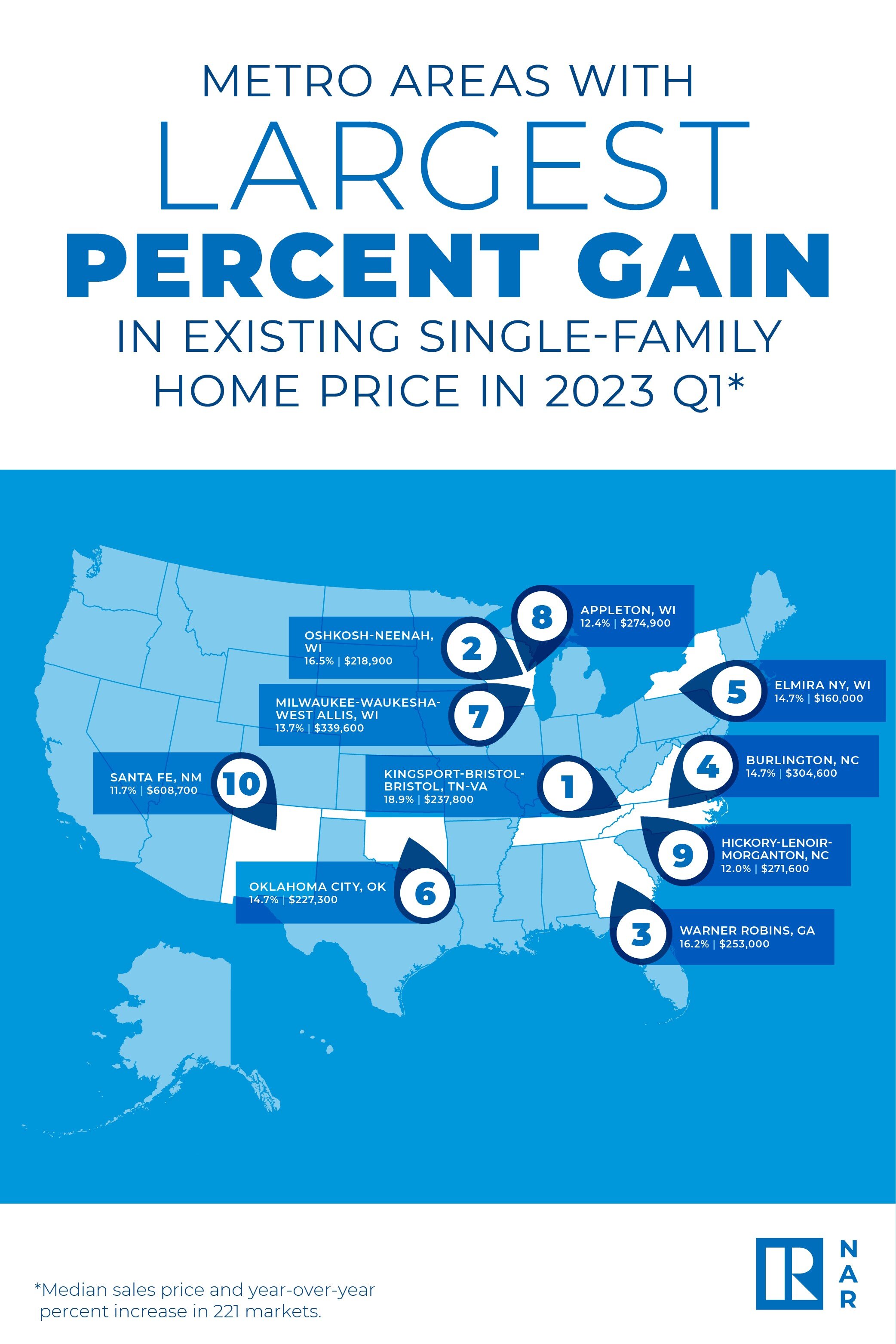Residential Real Estate News

Thirty One Percent of U.S. Metros Had Home Price Declines in Early 2023
Residential News » Philadelphia Edition | By David Barley | May 10, 2023 8:35 AM ET
Nationally, the median U.S. home price slightly dipped in Q1
According to the National Association of Realtors' latest quarterly report, nearly seven out of 10 U.S. metro markets registered home price gains in the first quarter of 2023, as 31% of U.S. markets experienced home price declines in the first quarter.
Seven percent of the 221 tracked metro areas registered double-digit price increases over the same period, down from 18% in the fourth quarter of 2022.
Compared to a year ago, the national median single-family existing-home price decreased 0.2% to $371,200. In the previous quarter, the year-over-year national median price increased 4.0%.
Among the major U.S. regions, the South saw the largest share of single-family existing-home sales (46%) in the first quarter, with year-over-year price appreciation of 1.4%. Prices climbed 2.9% in the Midwest yet slipped 0.1% in the Northeast and 5.3% in the West.
"Generally speaking, home prices are lower in expensive markets and higher in affordable markets, implying greater mortgage rate sensitivity for high-priced homes," said NAR Chief Economist Lawrence Yun.
Yun noted that cities in the West like San Francisco, San Jose and Reno saw home prices drop by at least 10% from a year ago. Conversely, prices rose by at least 10% from the previous year in cities like Milwaukee, Dayton and Oklahoma City.
"Home prices are also lower in cities that previously experienced rapid price gains," Yun added. "For example, home prices grew an astonishing 67% in three years in Boise City and Austin through 2022. The latest price reductions in these areas have improved housing affordability and led to some buyers returning given the sustained, rapid job creation in their respective markets."
Year-over-year prices in the first quarter declined by 13.5% in Austin, 10.3% in Boise and 7.3% in Phoenix.
"Due to the intense housing inventory shortage, multiple offers are returning, especially on affordable homes," Yun said. "Price declines could be short-lived."
Inventory in the first quarter averaged 1,630,000 listings at any given time, a 40% reduction from the first quarter of 2019 - a year before the onset of the COVID-19 pandemic.
The top 10 metro areas with the largest year-over-year price increases all recorded gains of at least 11.7%, with three of those markets in Wisconsin and two in North Carolina. Those include Kingsport-Bristol-Bristol, Tenn.-Va. (18.9%); Oshkosh-Neenah, Wis. (16.5%); Warner Robins, Ga. (16.2%); Burlington, N.C. (14.7%); Elmira, N.Y. (14.7%); Oklahoma City, Okla. (14.7%); Milwaukee-Waukesha-West Allis, Wis. (13.7%); Appleton, Wis. (12.4%); Hickory-Lenoir-Morganton, N.C. (12.0%); and Santa Fe, N.M. (11.7%).
Seven of the top 10 most expensive markets in the U.S. were in California, including San Jose-Sunnyvale-Santa Clara, Calif. ($1,618,400; -13.7%); Anaheim-Santa Ana-Irvine, Calif. ($1,195,500; -5.1%); San Francisco-Oakland-Hayward, Calif. ($1,192,600; -14.5%); Urban Honolulu, Hawaii ($1,029,000; -8.8%); San Diego-Carlsbad, Calif. ($880,000; -2.8%); Salinas, Calif. ($863,900; -6.8%); San Luis Obispo-Paso Robles, Calif. ($850,200; -3.8%); Oxnard-Thousand Oaks-Ventura, Calif. ($844,800; -5.6%); Boulder, Colo. ($836,900; -2.6%); and Naples-Immokalee-Marco Island, Fla. ($777,000; 4.3%).
Roughly three in 10 markets (31%; 68 of 221) experienced home price declines in the first quarter.
In the first quarter, housing affordability improved slightly from the fourth quarter of 2022 when mortgage rates eclipsed 7%. The monthly mortgage payment on a typical existing single-family home with a 20% down payment was $1,859. This represents a 5.5% decrease from the fourth quarter of last year ($1,967) but a jump of 33.1% - or $462 - from one year ago. Families typically spent 24.5% of their income on mortgage payments, down from 26.2% in the previous quarter but up from 19.5% one year ago.
First-time buyers found a small measure of relief when looking to purchase a typical home during the first quarter with the quarterly declines in prices and mortgage rates. For a typical starter home valued at $315,500 with a 10% down payment loan, the monthly mortgage payment fell to $1,825, down 5.4% from the previous quarter ($1,930) but an increase of almost $450, or 32.5%, from one year ago ($1,377). First-time buyers typically spent 37% of their family income on mortgage payments, down from 39.5% in the previous quarter. A mortgage is considered unaffordable if the monthly payment (principal and interest) amounts to more than 25% of the family's income.
A family needed a qualifying income of at least $100,000 to afford a 10% down payment mortgage in 33% of markets, down from 38% in the prior quarter. Yet, a family needed a qualifying income of less than $50,000 to afford a home in 10% of markets, up from 8.6% in the previous quarter.
Sign Up Free | The WPJ Weekly Newsletter
Relevant real estate news.
Actionable market intelligence.
Right to your inbox every week.
Real Estate Listings Showcase
Related News Stories
Residential Real Estate Headlines
- Las Vegas Area Home Prices Uptick 4.3 Percent Annually in March
- Single-Family Rent Growth in U.S. Trends Upward in 2025
- U.S. Mortgage Rates Tick Down Post Trump Tariffs Commencement
- President Trump's 'Liberation Day' Tariffs Potential Impact on the U.S. Housing and Mortgage Markets
- Baby Boomers Biggest Cohort of U.S. Home Buyers in 2025 as Millennials Decline
- U.S. Monthly Housing Payments Hit Record High in 2025
- U.S. Pending Home Sales Uptick in February
- Global Prime Residential Rent Slowdown Continued in Late 2024
- Ireland Home Price Inflation Hits 8 Year High in Early 2025
- Existing Home Sales in America Uptick in February
- Great Miami Area Residential Sales Decline 15 Percent Annually in February
- Mortgage Rates Uptick in Mid-March, Ending 9-Week Decline in U.S.
- World Property Ventures Builds the Future of Real Estate with New Funding Round
- U.S. Builder Sentiment Declines Amid Economic Uncertainty and Rising Costs
- Black Homeownership Rates in U.S. Enjoy Largest Annual Increase of All Racial Groups
- Wealthy Renters Are Taking Over More of the U.S. Rental Market
- If U.S. Congress Does Not Extend NFIP Soon, Thousands of Daily Home Closings Impacted
- U.S. Mortgage Applications Spike 11 Percent in Early March
- Greater Palm Beach Area Residential Sales Rise in Early 2025
- New Apartments in U.S. Are Leasing at Slowest Pace on Record
- U.S. Mortgage Rates Drop to 4 Month Low in March
- Overall U.S. Mortgage Delinquency Rates Dip in December
- New Tariffs on Canada, Mexico to Impact U.S. Homebuilder Input Costs
- Monaco's Property Market: A Tale of Two Cities
- U.S. Home Purchase Cancellations Surge, 1 in 7 Sales Getting Canceled
- U.S. Pending Home Sales Hit Historic Low in Early 2025
- Greater Miami Area Residential Sales Dip in January
- Governor DeSantis Supports Ending Property Taxes in Florida
- WPV Aims to Become the Berkshire Hathaway of Real Estate Tech
- U.S. Home Sales Slump Continues in January
- Average Americans Spend 38 Percent of Monthly Income on Mortgage Payments
- Switzerland's Safe-Haven Appeal Grows with World's Wealthy Homebuyers
- U.S. Builder Confidence Rapidly Declines in February
- Las Vegas Home Sales Rise 6.7 Percent Annually in January, Condo Sales Dip
- Homebuyer Demand in America Drops to 5-Year Low in Early 2025
- Ownership More Affordable Than Renting in Most U.S. Markets
- The World's First Global Listings Service Launches, Called a GLS
- Home Prices Continue to Rise in 89 Percent of U.S. Metros in Late 2024
- Global Luxury Residential Prices Showed Gradual Improvement in Late 2024
- U.S. Construction Hiring Rate Drops to Lowest Levels in 5 Years






